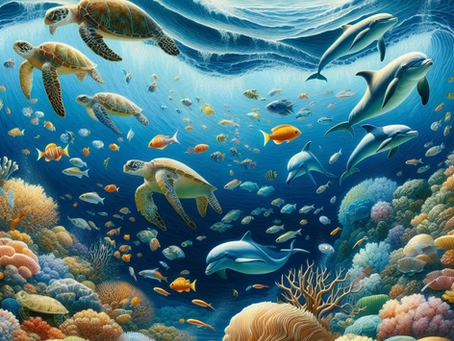The Dynamic Forces Shaping Our Oceans
Ocean currents represent one of Earth’s most powerful natural systems, functioning as a global conveyor belt that transports heat, nutrients, and marine organisms across vast distances. These continuous movements of seawater—driven by wind, temperature gradients, salinity differences, and planetary rotation—create complex patterns that influence everything from regional climates to marine biodiversity. Understanding these currents is essential for comprehending how our oceans function and how they respond to environmental changes, making this knowledge critical for effective marine conservation and climate adaptation strategies.
How Ocean Currents Form and Function
Ocean currents develop through the interaction of multiple physical forces that create both surface and deep-water movement.
Primary Driving Forces
Currents originate from several key mechanisms:
• Wind patterns: Prevailing winds drag surface waters, creating major current systems
• Thermohaline circulation: Density differences from temperature and salinity variations drive deep ocean currents
• Coriolis effect: Earth’s rotation deflects moving water, creating circular gyre patterns
• Topographic influence: Underwater mountains, trenches, and continental shapes steer current pathways
Surface Current Systems
The ocean’s surface layer (approximately upper 400 meters) contains well-defined current patterns:
• Equatorial currents: Flow westward along the equator between trade wind systems
• Western boundary currents: Intense, narrow flows along continental western edges (e.g., Gulf Stream)
• Eastern boundary currents: Broader, slower flows along continental eastern margins
• Polar currents: Circumpolar flows connecting ocean basins at high latitudes
Deep Water Circulation
Below the surface layer, massive water movements form the global conveyor belt:
• Formation: Dense water sinks at polar regions, initiating deep flows
• Pathways: These waters travel through ocean basins over centuries
• Upwelling: Deep waters eventually rise to surface in specific regions
Ecological Significance of Ocean Currents
Currents create and sustain marine ecosystems through multiple interconnected processes.
Nutrient Distribution and Productivity
Currents transport essential nutrients that support marine food webs:
• Upwelling zones: Bring nutrient-rich deep waters to sunlit surface areas
• Convergence zones: Where currents meet, concentrating plankton and nutrients
• Vertical mixing: Turbulent areas that recycle nutrients through water columns
Species Distribution and Migration
Currents influence marine life patterns in several ways:
• Larval dispersal: Transport young organisms to new habitats
• Migration highways: Provide pathways for seasonal animal movements
• Population connectivity: Link separated populations through gene flow
Habitat Formation and Maintenance
Specific current conditions create unique marine environments:
• Coral reef systems: Depend on currents for food delivery and temperature regulation
• Kelp forests: Require nutrient-rich currents for growth and productivity
• Deep-sea ecosystems: Rely on current-borne organic material as food source
Climate Regulation Through Ocean Currents
The ocean’s circulation system plays a fundamental role in Earth’s climate stability.
Heat Redistribution
Currents moderate global temperatures by:
• Poleward heat transport: Moving warm tropical waters toward higher latitudes
• Equatorial cooling: Returning cooler waters to tropical regions
• Regional moderation: Influencing coastal climates through adjacent currents
Carbon Cycle Participation
Ocean circulation affects atmospheric carbon dioxide through:
• Physical pump: Solubility differences drive CO2 absorption in cold waters
• Biological pump: Currents transport carbon to deep ocean through sinking organic matter
• Storage capacity: Deep waters sequester carbon for centuries to millennia
Climate Pattern Influence
Currents interact with atmospheric systems to create:
• Monsoon systems: Seasonal current reversals influence rainfall patterns
• El Niño/La Niña: Changes in equatorial currents affect global weather
• Multi-decadal oscillations: Slow current variations influence long-term climate patterns
Human Impacts and Conservation Considerations
Human activities increasingly affect ocean circulation with significant consequences.
Climate Change Effects
Global warming alters current systems through:
• Melting ice: Freshwater input changes density-driven circulation
• Temperature changes: Alters current strength and distribution patterns
• Wind pattern shifts: Affects surface current generation and direction
Pollution Transport
Currents distribute pollutants across ocean basins:
• Plastic accumulation: Converging currents create garbage patches
• Chemical dispersal: Spreads contaminants from localized sources
• Oil spill movement: Currents determine impact areas from spills
Conservation Strategies
Protecting current-dependent ecosystems requires:
• Marine protected areas: Safeguarding critical current-influenced habitats
• Fisheries management: Accounting for current-driven population connectivity
• Climate adaptation: Preparing for changes in current-influenced patterns
Research and Monitoring Approaches
Scientists employ multiple methods to study ocean currents and their changes.
Direct Measurement Techniques
Current monitoring uses various instruments:
• Drifting buoys: Track surface current movements
• Moored arrays: Measure current speed and direction at fixed locations
• Underwater gliders: Profile currents throughout water columns
Remote Sensing Technologies
Satellite-based systems provide global coverage:
• Altimetry: Measures sea surface height to infer current patterns
• Temperature sensing: Tracks warm and cold water movements
• Synthetic aperture radar: Detects surface current features
Modeling and Prediction
Computer simulations help understand current systems:
• General circulation models: Simulate global ocean circulation patterns
• Regional models: Focus on specific current systems and their dynamics
• Climate projections: Predict how currents may change in warming world

